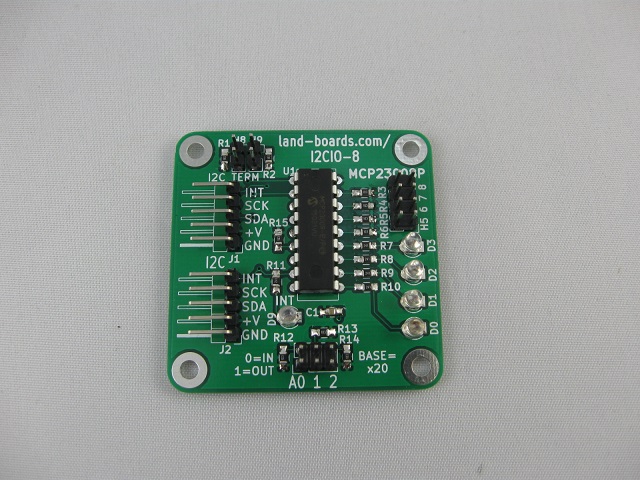Difference between revisions of "I2CIO-8"
Jump to navigation
Jump to search
Blwikiadmin (talk | contribs) |
Blwikiadmin (talk | contribs) |
||
| Line 29: | Line 29: | ||
* [https://github.com/land-boards/lb-Python-Code/tree/master/MicroPython/ESP32/libraries/I2CIO8 Github repo] - MicroPython Driver | * [https://github.com/land-boards/lb-Python-Code/tree/master/MicroPython/ESP32/libraries/I2CIO8 Github repo] - MicroPython Driver | ||
| − | == | + | == Factory Acceptance Test == |
| − | * | + | === Test Station Theory of Operations === |
| − | ** [ | + | |
| − | ** | + | * Test Station controls the I2C interface on the UUT |
| − | + | * Three tests | |
| − | * | + | ** Internal Test |
| + | ** External Loopback Test | ||
| + | ** Bounce an LED Test | ||
| + | |||
| + | === Test Station Set-up === | ||
| + | |||
| + | * Uses [[Arduino_Based_Test_Station|ODAS Test Station V2]] | ||
| + | * Ribbon cable sets | ||
| + | ** Loopback cable Connector | ||
| + | ** [[LED-32]] cable | ||
| + | * Unit Under Test (UUT) | ||
| + | * Attach Host Computer USB to the Arduino NANO on the Test Station | ||
| + | * Run puTTY on the Host Computer | ||
| + | ** 9600 baud | ||
| + | |||
| + | === Card Selection === | ||
| + | * puTTY will display the menu | ||
<pre> | <pre> | ||
| − | + | Checking if EEPROM is present on UUT...EEPROM is not present on UUT | |
| + | Count of I2C devices in range 0x20-0x27 on UUT = 1 | ||
| + | Detected MCP23008 | ||
| + | Select the board type (Other) | ||
| + | 1 - I2CIO8 board | ||
| + | 2 - I2CIO8X board | ||
| + | Select board > | ||
</pre> | </pre> | ||
| + | |||
* Select 1 | * Select 1 | ||
| + | |||
| + | <pre> | ||
| + | Init I2CIO-8 card | ||
| + | C=Card Tests, D=Direct, E=EEPROM, I=access Internal DIGIO32 | ||
| + | </pre> | ||
| + | |||
| + | === Running Loopback Card Test === | ||
| + | |||
| + | * Use loopback cable | ||
| + | * Select Card Tests = "C" | ||
| + | * Select Run Tests = "T" | ||
| + | * Observe test results | ||
| + | <pre> | ||
| + | L=Loop/S=Single, T=Test, B=Bounce LEDs, I=UUT Int'l Test, X=eXit sub-menu | ||
| + | Testing UUT = I2CIO-8 | ||
| + | Test PASS = 1, FAIL = 0 | ||
| + | </pre> | ||
| + | * Hit ENTER to display menu | ||
<pre> | <pre> | ||
| − | Select | + | L=Loop/S=Single, T=Test, B=Bounce LEDs, I=UUT Int'l Test, X=eXit sub-menu |
| − | + | </pre> | |
| + | |||
| + | === Running Internal Tests === | ||
| + | |||
| + | * Remove loopback cable | ||
| + | * Select Card Tests = "C" | ||
| + | * Select Run Tests = "I" | ||
| + | * Observe test results | ||
| + | <pre> | ||
| + | L=Loop/S=Single, T=Test, B=Bounce LEDs, I=UUT Int'l Tests, X=eXit sub-menu | ||
| + | UUT Internal card tests | ||
| + | Test PASS = 2, FAIL = 0 | ||
| + | </pre> | ||
| + | * Hit ENTER to display menu | ||
| + | <pre> | ||
| + | L=Loop/S=Single, T=Test, B=Bounce LEDs, I=UUT Int'l Test, X=eXit sub-menu | ||
</pre> | </pre> | ||
| − | * Select C | + | |
| + | === Running Blink LED Test === | ||
| + | |||
| + | * Attach [[LED-32]] cable | ||
| + | * Select Card Tests = "C" | ||
| + | * Select Run Tests = "B" | ||
| + | * Observe LEDs scanning on [[LED-32]] | ||
<pre> | <pre> | ||
| − | + | L=Loop/S=Single, T=Test, B=Bounce LEDs, I=UUT Int'l Test, X=eXit sub-menu | |
| + | Bounce a bit across outputs | ||
| + | Bouncing LEDs I2CIO8 - any key to stop | ||
</pre> | </pre> | ||
| − | * | + | * Hit ENTER to display the menu |
<pre> | <pre> | ||
| − | + | Finished bouncing LEDs | |
</pre> | </pre> | ||
| − | + | ||
| − | + | === Reference === | |
| − | + | ||
| − | * | + | * [[Arduino Based Test Station]] |
| − | * | + | * [https://github.com/land-boards/lb-Arduino-Code/tree/master/LBCards/ODAS/ODASTESTER ODAS Tester Github Repo] |
== Assembly Sheet == | == Assembly Sheet == | ||
* [[I2CIO8-X Assembly Sheet]] | * [[I2CIO8-X Assembly Sheet]] | ||
Revision as of 20:17, 21 March 2022
Contents
Features
- 8 bits of Digital I/O
- I2C interface
- MCP23008 - 8-Bit I/O Expander with I2C Interface
- Base address = 0x20
- Address offset jumpers (0-7)
- Interrupt pin on I2C connectors
- Interrupt LED
- I2C Daisy-chain connectors
- 4 input (or output) jumpers
- 4 LEDs
- 2.7V to 5.5V
- 49x49mm form factor
- (4) #4-40 mounting holes
Drivers/Example Code
Extensive Driver Support for Arduino, Raspberry Pi, MicroPython, ESP-32, Blue Pill Board, Cypress PSoC
- Github repo - Arduino Driver code
- Github repo - Arduino Example code
- Github repo - MicroPython Driver
Factory Acceptance Test
Test Station Theory of Operations
- Test Station controls the I2C interface on the UUT
- Three tests
- Internal Test
- External Loopback Test
- Bounce an LED Test
Test Station Set-up
- Uses ODAS Test Station V2
- Ribbon cable sets
- Loopback cable Connector
- LED-32 cable
- Unit Under Test (UUT)
- Attach Host Computer USB to the Arduino NANO on the Test Station
- Run puTTY on the Host Computer
- 9600 baud
Card Selection
- puTTY will display the menu
Checking if EEPROM is present on UUT...EEPROM is not present on UUT Count of I2C devices in range 0x20-0x27 on UUT = 1 Detected MCP23008 Select the board type (Other) 1 - I2CIO8 board 2 - I2CIO8X board Select board >
- Select 1
Init I2CIO-8 card C=Card Tests, D=Direct, E=EEPROM, I=access Internal DIGIO32
Running Loopback Card Test
- Use loopback cable
- Select Card Tests = "C"
- Select Run Tests = "T"
- Observe test results
L=Loop/S=Single, T=Test, B=Bounce LEDs, I=UUT Int'l Test, X=eXit sub-menu Testing UUT = I2CIO-8 Test PASS = 1, FAIL = 0
- Hit ENTER to display menu
L=Loop/S=Single, T=Test, B=Bounce LEDs, I=UUT Int'l Test, X=eXit sub-menu
Running Internal Tests
- Remove loopback cable
- Select Card Tests = "C"
- Select Run Tests = "I"
- Observe test results
L=Loop/S=Single, T=Test, B=Bounce LEDs, I=UUT Int'l Tests, X=eXit sub-menu UUT Internal card tests Test PASS = 2, FAIL = 0
- Hit ENTER to display menu
L=Loop/S=Single, T=Test, B=Bounce LEDs, I=UUT Int'l Test, X=eXit sub-menu
Running Blink LED Test
L=Loop/S=Single, T=Test, B=Bounce LEDs, I=UUT Int'l Test, X=eXit sub-menu Bounce a bit across outputs Bouncing LEDs I2CIO8 - any key to stop
- Hit ENTER to display the menu
Finished bouncing LEDs

